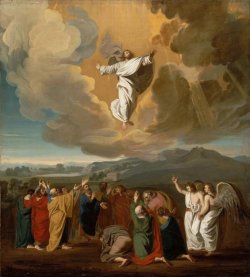|
Vicar's Musings for Easter 712 May, 2013 I was raised an Anglican, and after going to Sunday School, hearing a few sermons, and looking at my Dad's art books, John Singleton Copley's painting of the Ascension picture would have said it all. I didn't really think twice. Jesus died, rose again, and then physically ascended into heaven on a cloud just as the Biblical stories recount. "Isn't that physically impossible?" I might have asked myself in a questioning moment. "Well, it doesn't really matter because God can do anything" could have been my pat answer. Biblical scholar and theologian, Marcus Borg, points to a problem with this approach and terms it "the composite Jesus". He argues that when we think about the death, resurrection and ascension of Jesus Christ there are in fact two distinct but intimately connected realities we are considering. Jesus is not a supernatural figure able to leap into the sky at will to save the world. The mystery of Jesus is that he is fully human, as well as fully divine. Borg argues for an unpicking of the composite Jesus. In distinguishing between the pre-Easter Jesus and the post-Easter Jesus we come to a deeper and more robust understanding of our Lord Jesus Christ. On the one hand there is Jesus of Nazareth, the historical man, the pre-Easter Jesus. He lived. That is as verifiable as for any other figure of history. And what's more, he couldn't fly, even after death. Copley's painting is not meant to be taken literally; his depiction of the ascension is of course metaphorical. Jesus was a fully human being, not a Roman demi-god. In fact, if we hold to a naïve Biblically literalistic understanding of Jesus, without questioning it, we loose something important. The "post-Easter Jesus" is real, profoundly real and meaningful, but he is not the same as the "Pre-Easter Jesus." The two elements of Jesus need to be distinguished. Most biblical scholars now agree that Mark's gospel pre-dates all the other gospels and was probably written a generation after Jesus' death. It is interesting to note that the oldest copies of this gospel have a remarkably succinct ending. After Jesus' death, three disciples, all women, discover the empty tomb. They encounter an angel who tells them, "Do not be alarmed; you are looking for Jesus of Nazareth, who was crucified. He has been raised; he is not here" and then they flee from the empty tomb in "terror and amazement" and say nothing "for they were afraid" (16:6-8). There are no bodily resurrection narratives and no account of the ascension. Mark and the community he wrote for seem to be struggling for words to describe the incredible things that are happening among the first-century Christians. Some time later Mark's community expanded the ending, adding three resurrection stories and an account of Jesus' final ascension into heaven. The other gospels followed suit, and by the time of John's gospel, written at least two generations after Jesus' death, we have a wealth of highly developed accounts of the risen and ascended Christ. So, what was going on? Where did these post-Easter stories come from? Importantly, they are not historical accounts in the way we understand history today. They are gospel stories, written by the early evangelists, aimed at a first-century audience with the sole purpose of evoking faith and proclaiming the gospel of Jesus Christ amidst scepticism and even persecution. After Jesus' death an amazing thing was starting to happen — people were experiencing the reality of God through the mystery of the risen Christ. It was like Jesus was really there among them. Paul had a vision on the road to Damascus. It turned his life around. The Holy Spirit was touching people's hearts; more and more people were experiencing the post-Easter Jesus, the Risen Christ, for themselves. Whole families of adults and children were being baptised into the faith. Jesus was not lost in the past, buried in a tomb, he was alive, the tomb was empty, he was still speaking into people's lives. And so the stories were told. Stories about the risen Christ, the ascended Christ, the here and now Christ of faith. And these stories are still being told and lived today. As a priest I hear them all the time, and I have experienced something of this reality myself. It is as profound and life-changing now as it was then. And so we proclaim the mystery of faith: Christ has died, Christ is risen, Christ will come again. The Rev'd Dr Hugh Kempster |

Views is a publication of |
|
Authorized by the Vicar
(vicar@stpeters.org.au) |
